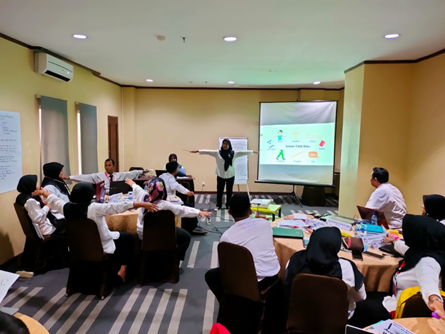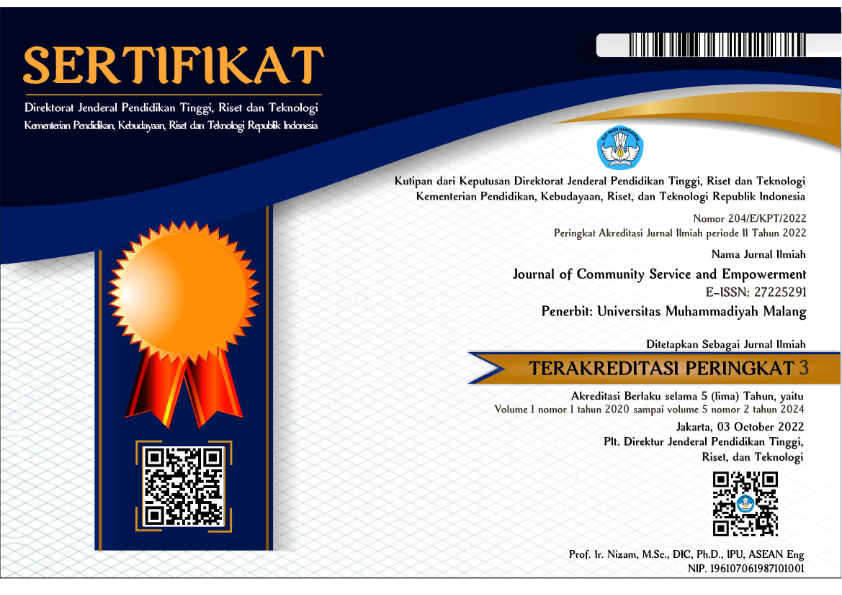Training of HOTS integration in elementary school level mathematics teaching as an effort to strengthen state defense awareness
DOI:
https://doi.org/10.22219/jcse.v5i3.32943Keywords:
Elementary School, HOTS, Mathematics Teaching, State Defense AwarenessAbstract
Strengthening state defense awareness could be supported by the existence of educators from remote and border areas who have adequate performance of high-order thinking skills (HOTS). Currently, HOTS has not been consistently introduced in mathematics learning for teachers in remote areas. This study is a part of the teachers’ development program concerned with delivering effective methods in teaching mathematics at the elementary school level and gaining teachers’ State Defense Awareness to provide educators’ perspectives regarding HOTS implementation in mathematics learning in remote areas of Indonesia. Data was collected by giving questionnaires to the teachers as pre-tests and post-tests. The results showed that the teachers of some remote areas recognized the advantages as well as the difficulties of HOTS integration in learning activities. Teachers' understanding of applying HOTS in mathematics teaching could be slightly increased through comprehensive training regarding HOTS. It was also found that teachers from remote and border areas are still required to be more encouraged to implement and develop HOTS in mathematics learning through training in education research activities.
Downloads
References
Adianto, T., Sulistiyanto, S., Pudjiatmoko, S., & Ali, Y. (2019). Contribution analysis of the state defense awareness programme towards the national character building. Jurnal Pertahanan, 5(2), 26. https://doi.org/10.33172/jp.v5i2.512
Aditya Dewantara, J., Purnama, S., & Mirzachaerulsyah, E. (2021). Transnationalism threat to the indonesian society in the border area of Indonesia-Malaysia (study on camar bulan society). 7(3), 2549–9459. https://doi.org/10.33172/jp.v7i3
Ali, L. U., & Zaini, M. (2023). Development of interactive e-modules based on local wisdom using android to improve students’ higher order thinking skills (HOTS). Jurnal Penelitian Pendidikan IPA, 9(11), 10091–10100.
As’ari, A. R., Mahmudi, A., & Nuerlaelah, E. (2017). Our prospective mathematic teachers are not critical thinkers yet. Journal on Mathematics Education, 8(2), 145–156. https://doi.org/10.22342/jme.8.2.3961.145-156
Aulia, R., & Darmawan, C. (2021). The actualization of civic education in strengthening youth generation state defense spirit. Advances in Social Science, Education and Humanities Research, 581, 315–319.
Brenya, B. (2024). Higher education in emergency situation: Blended learning prospects and challenges for educators in the developing countries. Journal of Applied Research in Higher Education, 16(4), 1015–1028.
Dinni, H. N. (2018). HOTS (High Order Thinking Skills) dan kaitannya dengan kemampuan Literasi Matematika. PRISMA Prosiding Seminar Nasional Matematika 1, 170–176. https://journal.unnes.ac.id/sju/index.php/prisma/
Eisenhart, M. A., & Weis, L. (2022). STEM education reform in urban high schools: Opportunities, constraints, culture, and outcomes. Harvard Education Press.
Fadillah, S., & Saputro, M. (2017). Students’ academic self-concept and their ability in solving Mathematical problems. https://doi.org/10.18269/jpmipa.v22i2.7927
Fauzia Hakim, R., Triatna, C., & Info, A. (2022). Jurnal pertahanan media informasi tentang kajian dan strategi pertahanan yang mengedepankan identity. Nationalism Dan Integrity, 8(2), 2549–9459. https://doi.org/10.33172/jp
Fitriani, R., Iskandar, I., & Suseno, M. (2023). The implementation of higher order thinking skills (HOTS) in English language teaching: A case of indonesian senior high school EFL teachers. Didaktika: Jurnal Kependidikan, 12(4), 739–750.
Fitriani, T., & Pertahanan, R. (2021). Education linearity: The shackle of disruption era in industrial revolution 4.0 from the defense perspective. 7(2), 2549–9459. https://doi.org/10.33172/jp.v7i2
Haniah, A. R., Aman, A., & Setiawan, R. (2020). Integration of strengthening of character education and higher order thinking skills in history learning. Journal of Education and Learning (EduLearn), 14(2), 183–190.
Indriani, L., Nugrahaeni, D. A., Manggolo, N. S. K. H., & Rahardi, P. (2023). Teacher professional development:’’Be a force for good’’. Journal of Community Service and Empowerment, 4(3), 500–511.
Jupri, A., & Rosjanuardi, R. (2020). Analysis of teacher understanding of Mathematical literacy problems. https://doi.org/10.18269/jpmipa.v25i1.21690
Kiswanto Kenedi, A., Helsa, Y., Ariani, Y., Zainil, M., Hendri Universitas Negeri Padang, S., & Hamka Air Tawar, J. (2019). Mathematical connection of elementary school students to solve mathematical problems. Journal on Mathematics Education, 10(1), 69–80.
Liu, H.-Y., & Maas, M. M. (2021). ‘Solving for X?’ Towards a problem-finding framework to ground long-term governance strategies for artificial intelligence. Futures, 126, 102672.
Lord, T., Lee, H.-S., Horwitz, P., Pryputniewicz, S., & Pallant, A. (2024). A Remote view into the classroom: analyzing teacher use of digitally enhanced educative curriculum materials in support of student learning. Journal of Science Teacher Education, 35(2), 127–152.
Muthmainnah, M. (2023). Expanding on the use of YouMiMe as technology instructional design in learning. Pegem Journal of Education and Instruction, 13(1), 367–378.
Nikolic, S., Daniel, S., Haque, R., Belkina, M., Hassan, G. M., Grundy, S., Lyden, S., Neal, P., & Sandison, C. (2023). ChatGPT versus engineering education assessment: A multidisciplinary and multi-institutional benchmarking and analysis of this generative artificial intelligence tool to investigate assessment integrity. European Journal of Engineering Education, 48(4), 559–614.
Pariyatman, M. H., Madjid, A., Santoso, P., Saragih, H., & others. (2023). Defense strategy in dealing with threats of national security. International Journal Of Humanities Education and Social Sciences, 2(6).
Petek, E., & Bedir, H. (2018). An adaptable teacher education framework for critical thinking in language teaching. Thinking Skills and Creativity, 28, 56–72. https://doi.org/10.1016/j.tsc.2018.02.008
Prayitno, A., Rachman, A., & Sang Fajar El Harry, P. (2021). Management of pancasila and citizenship education in the prevention and handling of radicalism and terrorism in the state defense system. Jurnal Pertahanan, 8(1), 2549–9459. https://doi.org/10.33172/jp.v
Primasanti, I., Somakim, Darmawijoyo, & Eliyati, N. (2020). The development of HOTS problems on geometry and measurement for junior high school. Proceedings of the International Conference on Progressive Education (ICOPE 2019), 28–32. https://doi.org/10.2991/assehr.k.200323.084
Rachmawati, D., Suharno, S., & Roemintoyo, R. (2023). Analysis of the implementation of HOTS-based learning in vocational high schools. AIP Conference Proceedings, 2590(1).
Reis, S. M., & Renzulli, J. S. (2023). The schoolwide enrichment model: A focus on student strengths & interests. In Systems and models for developing programs for the gifted and talented (pp. 323–352). Routledge.
Sadijah, C., Murtafiah, W., Anwar, L., Nurhakiki, R., & Cahyowati, E. T. D. (2021). Teaching higher-order thinking skills in mathematics classrooms: Gender differences. Journal on Mathematics Education, 12(1), 159–179. https://doi.org/10.22342/jme.12.1.13087.159-180
Sidiq, Y., Ishartono, N., Desstya, A., Prayitno, H. J., Anif, S., & Hidayat, M. L. (2021). Improving elementary school students’ critical thinking skill in science through hots-based science questions: A quasi-experimental study. Jurnal Pendidikan IPA Indonesia, 10(3), 378–386. https://doi.org/10.15294/JPII.V10I3.30891
Stiawan, E., Basuki, R., Liliasari, L., & Rohman, I. (2022). Enhancement of Indonesian high school student conceptual mastery on vsepr topic using virtual simulation of molecule shapes: A case study of quasi-experimental evidence. JPII, 11(4), 511–518. https://doi.org/10.15294/jpii.v11i4.36385
Stiawan, E., Liliasari, & Ijang Rohman. (2014). Pengembangan keterampilan berpikir kritis siswa sma pada topik teori domain elektron melalui simulasi interaktif PhET molecule shapes. Jurnal Pengajaran MIPA, 19(2), 257–265. https://doi.org/doi.org/10.18269/jpmipa.v19i2.36187.g15567
Surya, E., Sabandar, J., & Kusumah, Y. S. (2013). Improving of Junior High School Visual Thinking Representation Ability in Mathematical Problem Solving by CTL (Vol. 4, Issue 1).
Suwaryo, P. A. W., Santoso, D., Yuda, H. T., Nugroho, I. A., & Hariyady, H. (2024). Effective strategies to enhance awareness and proficiency in open wound emergency management for students. Journal of Community Service and Empowerment, 5(2), 290–294. https://doi.org/10.22219/jcse.v5i2.27253
Tyas, M. A., Nurkamto, J., Marmanto, S., & Laksani, H. (2019). Developing higher order thinking skills (HOTS) – based questions: Indonesian EFL teachers’ challenges. 52–63. https://doi.org/10.17501/26307413.2019.2106
UN United Nations. (2023). The sustainable development goals report 2023: Special edition towards a rescue plan for people and planet.
Wahyudi, W., Affandi, I., Darmawan, C., Tippe, S., Nurisnaeny, P. S., & Dewantara, J. A. (2020). Community civic education in the indonesian border areas (study in the Central Sebatik District, North Kalimantan Province). Jurnal Pertahanan: Media Informasi Ttg Kajian & Strategi Pertahanan Yang Mengedepankan Identity, Nasionalism & Integrity, 6(3), 472. https://doi.org/10.33172/jp.v6i3.797
Wahyudin, D. (2020). The readiness of management and faculty members in implementing new curriculum in Universitas Pendidikan Indonesia. Applied Science and Innovative Research, 4(2), p27. https://doi.org/10.22158/asir.v4n2p27
Widjaja, W. (2013). The use of contextual problems to support Mathematical learning. IndoMS-JME, 4, 151–159.
Yohanes, Y., Olifiani, L. P., Akbar, I., & others. (2023). Geopolitical policy of cross-border post as an effort to improve society welfare on border of Indonesia. Res Militaris, 13(2), 86–96.
Zuraida, I., Kariadinata, R., & Susilawati, W. (2015). Mind map siklus dan mind map laba-laba untuk meningkatkan kemampuan berpikir kreatif siswa smp pada pokok bahasan bangun ruang. Jurnal Pengajaran Matematika Dan Ilmu Pengetahuan Alam, 20(1), 11. https://doi.org/10.18269/jpmipa.v20i1.556

Downloads
Published
How to Cite
Issue
Section
License
Copyright (c) 2024 Elva Stiawan, Rahmat Basuki, Ajeng Arimby Setyaningsih Putri Yan Prawira

This work is licensed under a Creative Commons Attribution-ShareAlike 4.0 International License.












